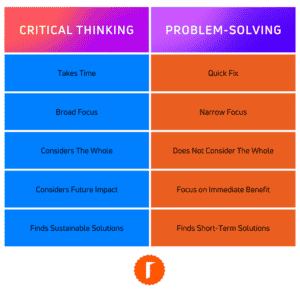Critical thinking ranks among the highest desirable job skills that leaders and managers are seeking in potential employees.
Strangely enough, many leaders and employees alike have lost sight of the difference between problem-solving and critical thinking, and it’s hindering their ability to nurture this very important skill.
In an age of influencers and disruptors, where being first and getting things done quickly for instantaneous rewards has become the norm, critical thinking and the benefits it provides often get bypassed in the race to the finish line.
Problem Solving Is NOT Critical Thinking
Problem-solving is an important skill but one that focuses specifically and narrowly on the presenting problem. It approaches the problem as an isolated thing.
For example, if a person arrives at the hospital with a broken finger, you would call in your problem solver, the doctor of orthopedics. They would examine the finger, locate the break, consider the optimal way to set the finger, and so on. In a nutshell, the finger would get the entire focus.
Critical thinking is taking a broader view of a problem to examine the whole ecosystem in which the problem exists. There is consideration of the people involved, the business, and all the other factors that past knowledge and experiences bring. Critical thinking goes beyond the immediate outcome and considers the ripple effect of decision-making.
For example, if a person arrives at the hospital reporting extreme fatigue and hair loss, a critical thinker would be more useful. Instead of looking at the symptoms and quickly concluding the cause, a critical thinker would investigate and ask questions of the person experiencing the issues. What is their lifestyle like? Have they made any recent changes? Do they have any known allergies? What are their stress levels like? Are there age-related factors? Etc. In other words, a holistic overview of the patient would be necessary for proper treatment.

Critical thinking demands time, energy, effort, and integrity. It involves reflection, which isn’t always easy since, at times, it can require an individual to face ethical dilemmas.
The DEI (diversity, equality, and inclusion) movement is a great example of where reflection is critical. In the race to answer to the demand for inclusive workplaces, many well-meaning business leaders took swift action within their organizations to become diversity sensitive. They hired diverse-looking people and began righting inequalities in pay and opportunity due to gender, etc.
Unfortunately, in the majority of cases, those actions didn’t result in the cultural changes the leaders had hoped for. Their quick fixes, although important, failed to account for the entire ecosystem that created the inequalities in the first place. Although they took diversity-sensitive action, they hadn’t done the work of investigating the beliefs, attitudes, and behaviors of the workforce that create cultural competency, including shining a light on their own internal biases.
Problem-solving is much like using a tourniquet on a gushing wound to slow the loss of blood. It’s an important step, but not sufficient to heal the wound.
As you can see, both critical thinking and problem-solving skills are important, but individuals who can discern when to use each or both are vital to the success of an organization. Critical thinking is being sought after more than ever as organizations become more socially conscious, employee-friendly, culturally diverse, and sensitive.
How to Nurture Critical Thinking
If you are interested in sharpening your critical thinking skills, here’s how to get started:
- Learn to set aside your own emotions and biased opinions.
- Put aside the need to rush to a solution whenever possible.
- Risk providing a dissenting point of view.
- Consider if a broader view is necessary when problem-solving.
- Use your ethics and morals as a guiding compass.
- Surround yourself with credible sources of information.
- Seek counsel and guidance from “trusted’ advisors.
As someone in charge, you’ll want to:
- Define the timeline for the project. This will help the team determine if the project requires a quick fix (problem-solving), or thoughtful consideration (critical thinking).
- Foster a work environment that allows for questions and new ideas without judgment.
- Coach members of your team to discern when to problem-solve and think critically in their daily tasks.
Employees and leaders who employ critical thinking experience a deeper connection to work, increased engagement, greater job satisfaction, and ultimately greater success. They understand that their decision-making affects the entire organization, so they make decisions with careful thought and consideration. In other words, they become the kind of ignited leaders that the world needs more of.





